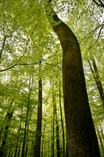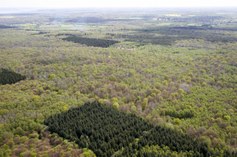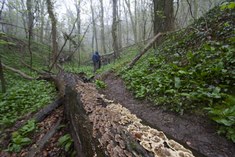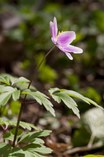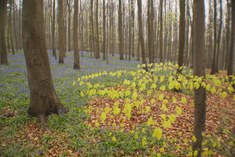Forests
ForNaLab has studied temperate forest ecosystems around the world, i.e., in Europe, North America, and South America. The focus of the forest research lies on (1) understanding the links between tree diversity and forest ecosystem functioning; (2) gaining insight into the impact of global changes on forest diversity, structure, and functioning; and (3) evaluating measures for sustainable, adaptive forest management aimed at optimizing biodiversity and multiple forest ecosystem services. A broad array of experimental and observational approaches are used to tackle the research questions.
Current projects
- Effects of N input, climate warming and management changes on the herb layer (more info)
- Effects of plant-soil feedbacks on colonization rates of forest herbs along a latitudinal gradient (more info)
- FORBIO: a large-scale field experiment on the effects of tree species diversity (more info)
- FORMICA: Microclimatic buffering of plant responses to macroclimate warming in temperate forests (more info)
- Impact of forest conversion on Lyme disease risk (more info)
- Impact of neighbourhood diversity on the growth of oak and pine (more info)
- N cycling and sequestration in temperate forest edges (more info)
- PASTFORWARD: Development trajectories of temperate forest plant communities under global change: combining hindsight and forecasting (more info)
- Quantifying the overstorey-understorey diversity relationships in forests (more info)
- Quantifying understorey responses to overstorey opening to better predict tree regeneration success (more info)
- SmallFOREST: Biodiversity and ecosystem services of small forest fragments in European landscapes (more info)
- Ecosystem services of soil-dwelling arthropods in small forest remnants (more info)
- The importance of microclimate for the prediction of forest plant responses to global warming (more info)
- The influence of small forest fragments on pollination services in an agricultural landscape (more info)
- TREEWEB: Scaling up functional biodiversity research from individuals to landscapes and back (more info)
Finished projects
- Acidification and eutrophication of forests on sandy soil: effects of forest type and deposition load (more info)
- Assessment of the effects of tree species diversity on FORest BIOdiversity and ecosystem functioning (FORBIO) (more info)
- Biomonitoring of air quality by using leaf characteristics of trees (more info)
- Can microbial community structure and selective nitrogen uptake explain differences in forest nitrogen dynamics (more info)
- Changes in bioavailability of phosphorus following afforestation of agricultural land (more info)
- Comparison of ecosystem functioning and biogeochemical cycles in temperate forests in southern Chile and Flanders (1999 – 2002) (more info)
- Decision support for harvesting methods of hardwood with large diameter in Flanders (more info)
- Defining guidelines for climate adaptation in the management of nature reserves in Flanders (more info)
- DYLCAFO: DYnamic Life Cycle Assessment on FOrestry (more info)
- Ecohydrological monitoring in managed and unmanaged forest ecosystems in southern Chile (2006-2007) (more info)
- Ecosystem development and pollutant cycling on buffer dikes constructed with dredged material (more info)
- Early tree diversity effects on tree growth, litter decomposition and herbivory (FORBIO) (more info)
- Effect of fire damage on regeneration and N loss from Araucaria araucana forests in southern Chile (2004 – 2005) (more info)
- Effects of climate change on Acer regeneration from seeds (more info)
- Effects of tree species induced soil acidification on litter and herb layer dynamics along a natural gradient of soil buffering capacity (more info)
- Effects of tree species’ litter and root decomposition products on the mobility of Cd and Zn in sandy soils (more info)
- Environmental, social and economic feasibility of forest conversion (more info)
- Evaluation of policy instruments for sustainable forest management and forest expansion in Flanders (more info)
- Forest edge effect on atmospheric deposition, nitrate leaching and soil acidification in forests on sandy soils (more info)
- Forest plant dynamics along a latitudinal gradient (more info)
- Forest understories: integrating below- and aboveground biotic interactions (more info)
- FunDivEUROPE: Functional significance of forest biodiversity in Europe (more info)
- Impact of a high density willow cover on the mobility and bioavailability of trace elements in contaminated dredged sediment (more info)
- Impact of converting former pine plantations on the abundance of the sheep tick (Ixodes ricinus L.) (more info)
- Impact of tree species mixture on chemical forest floor characteristics (more info)
- Mechanistic modeling of aqueous nitrogen uptake by tree canopies (more info)
- Model-based wood price predictions from public forest timber sales in Flanders (more info)
- Monitoring of the above and below ground C sequestration potential of Belgian forests and short rotation coppice on former agricultural land (more info)
- Nitrogen retention in contrasting temperate forest ecosystems in a region of high nitrogen (more info)
- Present and future population dynamics of black cherry (Prunus serotina Ehrh.) in forests in its introduced range deposition (more info)
- Reading ancient woodlands in the Campine region of Antwerp (northern Belgium). An exercise in historical ecology (more info)
- Recovery potential of forest plant communities on phosphate enriched farmland (more info)
- Refinement of a canopy budget model by analysing nutrient transfer processes in tree canopies at different spatio-temporal scales (more info)
- Relations between growth dynamics, forest management and wood characacteristics of birch on sandy soils in Flanders (more info)
- Risk assessment of agricultural intensification on N deposition on pristine forests and plantations in southern Chile (2001-2004) (more info)
- Seed ecology of common juniper (Juniperus communis) (more info)
- Seeing the trees for the wood: using 40 years of research in the forest Aelmoeseneie to answer current environmental questions (more info)
- Smart land management for biobased economies (more info)
- Soil compaction due to mechanized forest harvesting (more info)
- Spatial variability of throughfall water under beech (more info)
- Tree species effect on Cd and Zn mobility after afforestation of contaminated soils (more info)
- The effect of phosphorous bioavailability on the recovery of plant communities in post-agricultural forests (more info)
- The impact of the variation in tree leaf-out phenology on forest understorey plant communities (more info)
- The importance of landscape fragmentation and climate change to forest herb species in Northern Europe (FLEUR) (more info)
- Validation and optimalisation of forest friendly harvesting in Flanders (more info)
- FORBIOClimate: adaptation potential of biodiverse forests in the face of climate change (more info)
- Effects of temperature during seed development on progeny performance (more info)
- FORBIO: a large-scale field experiment on the effects of tree species diversity (more info)
- The interplay of biodiversity and environmental stress for ecosystem functioning (more info)
- The interplay of biodiversity and environmental stress for ecosystem functioning (more info)
